

5. Odds in Omaha Hi-Lo
In a 10-handed game of Omaha High or Omaha Hi-Lo, by the time the hand has been dealt, 45 of 52 cards are in play.
This means that in many cases, any nut hand that is possible has a very good chance of happening. For example, in Hold’em the odds of any player getting a pair of Aces in the hole is 220 : 1 but in Omaha it is 39 : 1.
In a 10-handed Hold’em game some player at the table will, on average, have Aces in the hole only once in each 22 hands, but in Omaha, on average someone will have rockets once every 4 hands.
Conventional poker wisdom notes that Omaha, whether High or Hi-Lo, is as much about “nut-peddling” as it is about anything else. The player should either have the best possible hand or be drawing to it.
One pitfall of Hi-Lo is that you can have the nut Low hand and still lose money. Consider a pot that is contested heads-up. Each of you has invested $500 in a $1000 pot. You have the nut Low, but your opponent has a hand that matches your Low and beats your High. You win $250 and your opponent takes $750. You end the hand with a $250 loss. Being “quartered” or worse in Hi-Lo sends many naive players to the rail.
147

5. Odds in Omaha Hi-Lo
The idea in Hi-Lo is to scoop both sides of the pot and NEVER to chase with marginal hands in either direction. To demonstrate the power of the scoop, assume that you are in a 3-handed pot and each player has $400 invested (for a total pot of $1,200). If you hold the nut Low and you are not quartered, you win $600 and make a $200 profit. If you scoop, you win $1,200 with an $800 profit. While your win is doubled, your profit is quadrupled. That is the power of the scoop.
148

Starting Hands
Starting Hands
Your first chance to gain an edge over your opponents is with your starting hands. The two keys to this edge are:
1.Play a higher quality starting hand than your opponents
2.Play the hand better than your opponents.
The strength of a hand matters more in split games than in non-split games. With both Low and High possibilities, calls are more likely and moves don’t work as often.
In a 10-handed game, the players’ hole cards represent over 3/4 of the deck. After the River card, 45 of 52 cards have been dealt to either the board or the players.
The significance of this almost complete distribution of the whole deck on every hand, is that whatever nut hands the board makes possible have a good chance of being held among the 40 cards at the table.
The table below shows the likelihood of you or any other specific player at the table receiving certain hands as hole cards in Omaha Hi-Lo.
Odds & Probabilities
Hand |
Probability |
Odds |
|
|
|
AAXX |
2.5% |
39 : 1 |
|
|
|
A2XX |
7.2% |
12.8 : 1 |
|
|
|
149

5. Odds in Omaha Hi-Lo
Hand |
Probability |
Odds |
|
|
|
A2 Suited to A |
2.7% |
36.1 : 1 |
|
|
|
A23X |
1.2% |
85.3 : 1 |
|
|
|
A23X Suited to A |
.28% |
351.5 : 1 |
AA2X |
.42% |
239 : 1 |
|
|
|
AA2X Single Suited to A |
.21% |
469 : 1 |
|
|
|
AA2X Double Suited |
.05% |
1879 : 1 |
AA23 |
.035% |
2,819.1 : 1 |
|
|
|
AA23 Single Suited |
.018% |
5,639.1 : 1 |
|
|
|
AA23 Double Suited |
.0044% |
22,559.4 : 1 |
|
|
|
2 Pair |
2.1% |
47.2 : 1 |
|
|
|
Probably Not Playable |
83.3% |
.2 : 1 |
|
|
|
The Calculations
The odds and probabilities can be calculated at least 2 ways:
1.Combinations — By using the basic combinations as demonstrated in Chapter 1, The Basic Calculations and Chapter 4, Odds in Texas Hold’em.
2.Probabilities — The probability of any starting hand can be determined by multiplying the probabilities of the individual cards or the probabilities of the sets that make up the 4-card starting hand.
It will prove easier to combine sets of 2-card combinations for almost all of these calculations.
150
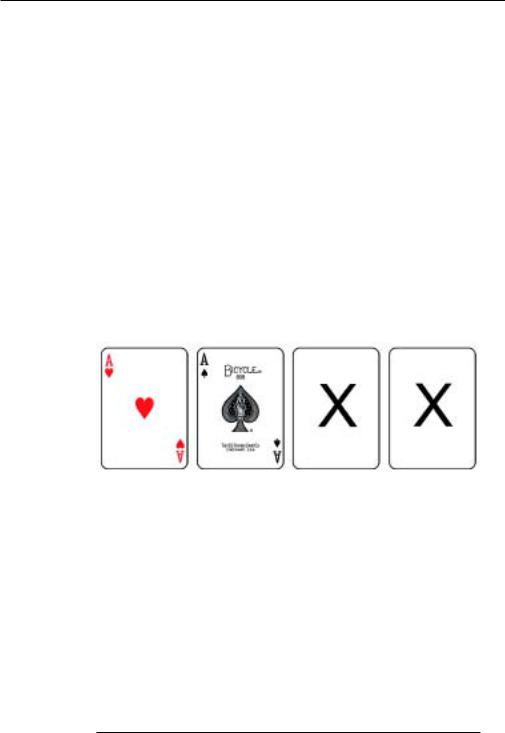
Starting Hands
As demonstrated in Chapter 1, The Basic Calculations and throughout this book, any odds are easily converted into probabilities and vice versa.
A number that will prove useful throughout these calculations is the total number of possible 4-card combinations in a 52-card deck — Comb(52, 4):
(52 * 51 * 50 * 49) = 270,725 (1 * 2 * 3 * 4)
There are 270,725 possible 4-card combinations from a deck of 52 cards.
AA
The odds of getting a pair of Aces in the hole in Omaha HiLo underscores the dramatic difference between Hold’em, with 2 cards in the pocket, and Omaha Hi-Lo, with 4 cards in the pocket.
With the odds of pocket rockets in Hold’em at 220 : 1 and the odds of AAxx in the hole in Omaha Hi-Lo at 39 : 1, you will see Aces in the hole more than 5 times as often in Omaha Hi-Lo as you will in Hold’em.
These odds can be calculated for exactly 2 Aces in the hole or
151

5. Odds in Omaha Hi-Lo
for 2 or more Aces in the hole. The calculation that will serve you best is for exactly 2 Aces in the hole, because in Omaha Hi-Lo, 3 or more cards of the same rank in the hole is NOT a good thing. Omaha Hi-Lo is one of the very few places in all of poker where a hand containing 4 hidden Aces is a huge disappointment.
Start with 270,725 — the total possible 4-card combinations from a deck of 52 cards.
Find the number of 2-card combinations that contain a pair of Aces — Comb(4, 2):
(4 * 3) = 6 (1 * 2)
The last number we need is the number of 2-card combinations that contain no Aces — Comb(48, 2):
(48 * 47) = 1,128 (1 * 2)
To find the total number of 4-card combinations that contain exactly 2 Aces, multiply the number of 2-card combinations that WILL contain 2 Aces (6) by the number of 2-card combinations that WILLNOT contain any Aces (1,128):
6 * 1,128 = 6,768
The probability of 2 and only 2 Aces in the pocket in Omaha Hi-Lo expressed as a percentage is
WILLs |
* 100 = Probability as % |
|
Total Possibilities |
||
|
270,7256.768 * 100 = 2.5%
152
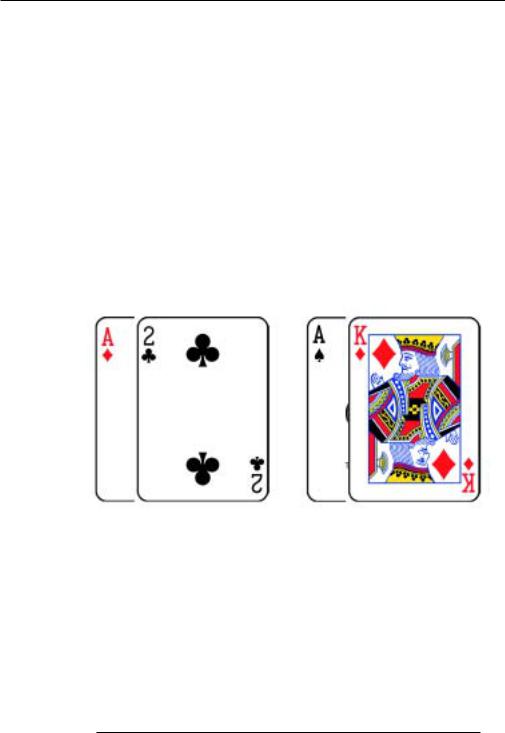
Starting Hands
The odds of exactly one pair of Aces in the hole in Omaha Hi-Lo are
Total Possibilities = 270,725
– WILLs = 6,768
WILLNOTs = 263,957
WILLNOTs (263,957) : WILLs (6,768) 263,957 : 6,768
Reduce
263,957 / 6,768 : 6,768 / 6,768
39 : 1
Any A2/AK
The odds/probability of finding any A2 or any AK in the hole in Omaha Hi-Lo are the same.
For this example we will calculate the odds of any A2 in the hole in Omaha Hi-Lo.
The total number of 4-card combinations possible from a 52-card deck is 270,725.
The number of 2-card combinations that contain A2 is
153

5. Odds in Omaha Hi-Lo
4 * 4 = 16
The number of 2-card combinations possible from the remaining 50 cards in the deck, including the possibility of one or more Aces or Deuces — Comb(50, 2) is
(50 * 49) = 1,225 (1 * 2)
To find the number of 4-card combinations that will contain any A2, multiply the number of possible A2 combinations (16) by the number of 2-card combinations possible from the remaining 50 cards in the deck:
16 * 1,225 = 19,600
The probability of A2 in the pocket in Omaha Hi-Lo expressed as a percentage is
WILLs |
* 100 = Probability as % |
|
Total Possibilities |
||
|
270,72519,600 * 100 = 7.2%
The odds of A2 in the hole in Omaha Hi-Lo are
Total Possibilities = 270,725
– WILLs = 19,600
WILLNOTs = 251,125
WILLNOTs (251,125) : WILLs (19,600) 251,125 : 19,600
Reduce
251,125 / 19,600 : 19,600 / 19,600
12.8 : 1
154
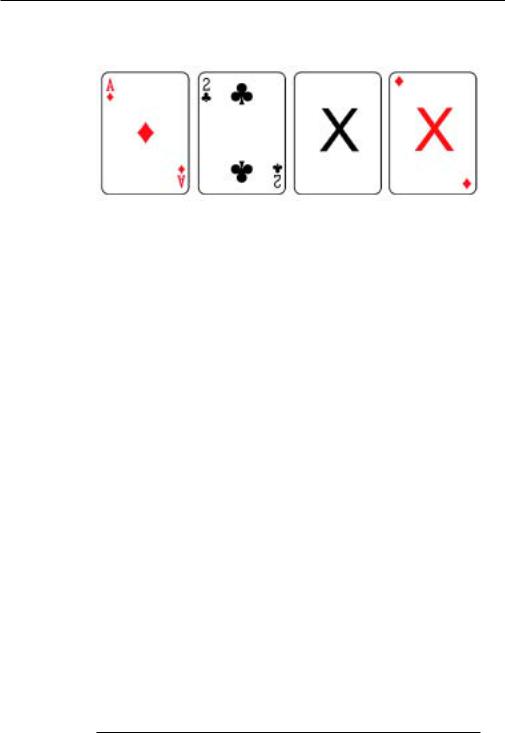
Starting Hands
A2/AK Single Suited to the Ace
For the Flush possibilities, it doesn’t matter whether the Deuce is suited to the Ace or not. It only matters that there is another card of the same suit as the Ace.
We will calculate the odds of having an A2 with the Ace suited to either the Deuce or any of the other cards.
The total number of 4-card combinations possible from a 52-card deck is 270,725.
The number of 2-card combinations that contain A2, including the possibility of a suited A2 is
4 * 4 = 16
The number of 2-card combinations that contain one or more cards suited to the Ace is the number of cards, other than the Ace of that suit (12), multiplied by the remaining 50–12 = 38 cards in the deck:
12 * 38 = 456
To find the number of 4-card combinations that will contain an A2 with the Ace suited to either the Deuce or 1 of the other cards in the hole, multiply the number of possible A2 combinations (16) by the number of 2-card combinations that contain one card suited to the Ace (456):
155
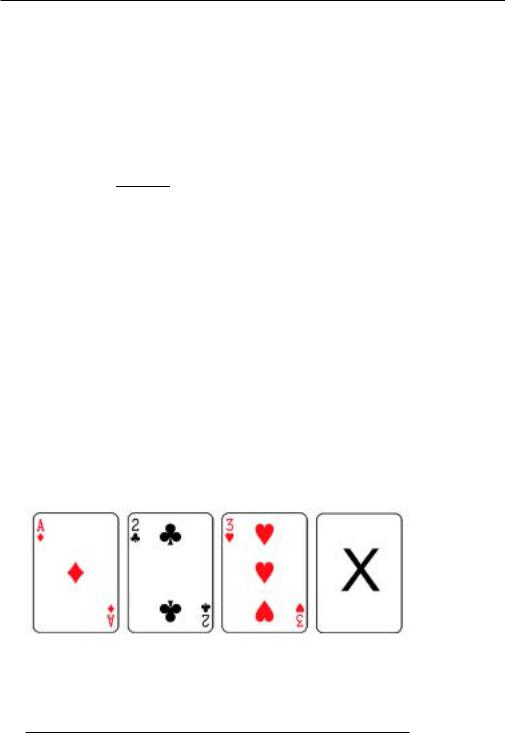
5. Odds in Omaha Hi-Lo
16 * 456 = 7,296
The probability of A2 with the Ace suited to either the Deuce or 1 of the other cards in the hole expressed as a percentage is:
WILLs |
* 100 = Probability as % |
|
Total Possibilities |
||
|
270,7257,296 * 100 = 2.7%
The odds of A2 with the Ace suited to either the Deuce or 1 of the other cards in the hole are:
Total Possibilities = 270,725
– WILLs = 7,296
WILLNOTs = 263,429
WILLNOTs (263,429) : WILLs (7,296) 263,429 : 7,104
Reduce
263,429 / 7,104 : 7,104 / 7,104
36.1 : 1
Any A23
The total number of 4-card combinations possible from a 52-card deck is 270,725.
156

Starting Hands
The number of 3-card combinations that contain A23 is:
4 * 4 * 4 = 64
The number of 4-card combinations that contain A23, including the possibility that one of the hole cards will be duplicated, is the number of 3-card combinations that contain A23 (64) multiplied by the number of cards remaining in the deck, including the remaining Aces, Deuces and Threes (49):
64 * 49 = 3,136
Or you can multiply the number of 2-card combinations that are possible to make A2 (16) by the number of 2-card combinations that contain at least one 3 (4 * 49 = 196):
16 * 196 = 3,136
The probability of A23 in the pocket expressed as a percentage is:
WILLs |
* 100 = Probability as % |
|
Total Possibilities |
||
|
270,7253,136 * 100 = 1.2%
The odds of A23 in the pocket are:
Total Possibilities = 270,725
– WILLs = 3,136
WILLNOTs = 267,589
WILLNOTs (267,589) : WILLs (3,136) 267,589 : 3,136
Reduce
267,589 / 3,136 : 3,136 / 3,136
85.3 : 1
157
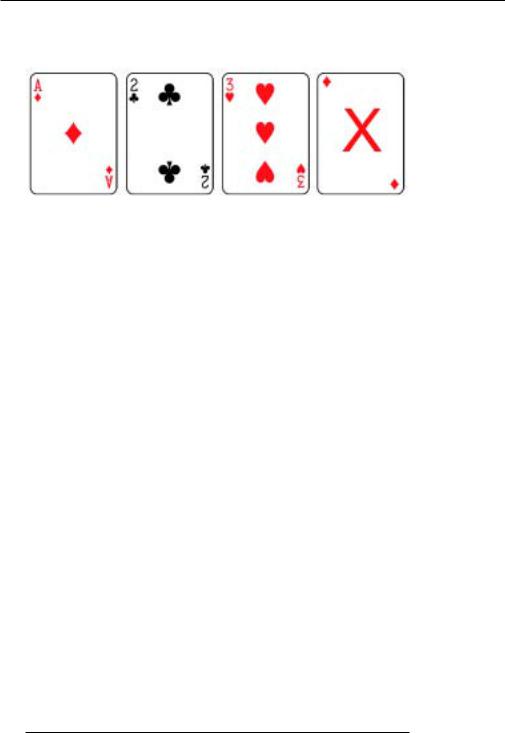
5. Odds in Omaha Hi-Lo
A23 Suited to the Ace
For the Flush possibilities, it doesn’t matter whether the 2 or the 3 is suited to the Ace — it only matters that there is another card of the same suit as the Ace.
For this example we will calculate the odds of having an A23 with the Ace suited to the Deuce, the Trey or the fourth card in the hole.
This calculation includes the possibility that more than one of the hole cards will be suited to the Ace.
We know that the total number of 4-card combinations possible from a 52-card deck is 270,725.
The number of 3-card combinations that contain A23, including the possibility of a suited A2 or suited A3 is:
4 * 4 * 4 = 64
To find the number of 4-card combinations that will contain an A23 with the Ace suited to the Deuce, the Trey, or the other card in the hole, multiply the number of possible A23 combinations (64) by 12, the number of remaining cards of the same suit as the Ace:
64 * 12 = 768
158
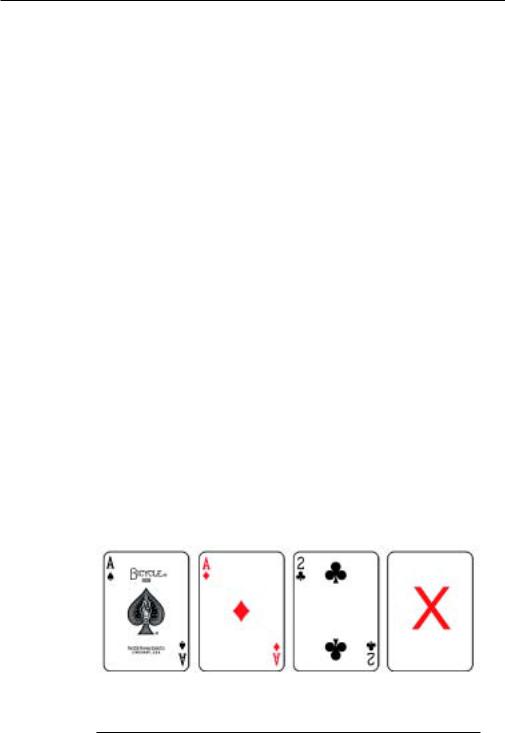
Starting Hands
The probability of A23 with the Ace suited to the Deuce, the Trey or the other card in the hole expressed as a percentage is
WILLs |
|
* 100 |
= Probability as % |
||
Total Possibilities |
|||||
|
|
||||
|
768 |
|
* 100 |
= .28% |
|
|
270,725 |
||||
Both of these calculations include the possibility of some duplication if the Ace is suited to either or both the Deuce and the Trey.
The odds of A23 with the Ace suited to the Deuce, the Trey or the other card in the hole are:
Total Possibilities = 270,725
– WILLs = 768
WILLNOTs = 269,957
WILLNOTs (269,957) : WILLs (768) 269,957 : 768
Reduce 269,957 / 768 : 768/ 768
351.5 : 1
Any AA2X
159

5. Odds in Omaha Hi-Lo
The total number of 4-card combinations possible from a 52-card deck is 270,725.
There are 6 2-card combinations that can contain a pair of Aces.
To find the number of 4-card combinations that can contain AA2x, multiply the number of possible pairs of Aces (6) by the number of 2-card combinations that can contain at least one Deuce and no Aces (4 * 47 = 188). The number of 4- card combinations that can contain one pair of Aces and one or more Deuces is:
6 * 188 = 1,128
The probability of AA2x in the hole expressed as a percentage is
WILLs |
* 100 = Probability as % |
|
Total Possibilities |
||
|
270,7251.128 * 100 = .42%
To find the odds of AA2x in the hole:
Total Possibilities = 270,725
– WILLs = 1,128
WILLNOTs = 269,597
WILLNOTs (269,597) : WILLs (1,128) 269,597 : 1,128
Reduce
269,597 / 1,128 : 1,128/ 1,128
239 : 1
160
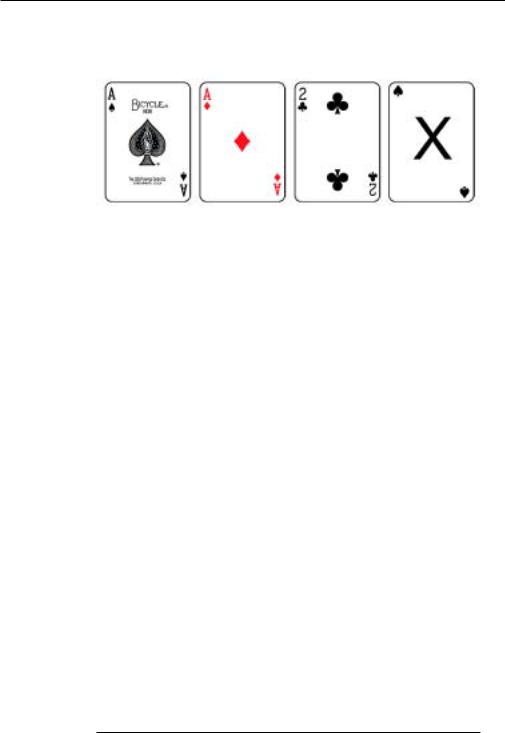
Starting Hands
AA2X Single Suited to A
For the Flush possibilities it doesn’t matter whether the Deuce or the fourth card is suited to one of the Aces. It only matters that one of those cards is suited to one of the Aces.
In this example we will calculate the odds of having an AA2 with one of the Aces suited to either the Deuce or the fourth card in the hole.
This includes the possibility that more than one of the hole cards will be suited to either Ace.
The total number of 4-card combinations possible from a 52-card deck is 270,725.
There are 6 2-card combinations that can contain a pair of Aces.
To find the number of 4-card combinations that can contain AA2x single suited, multiply the number of possible pairs of Aces (6), by the number of 2-card combinations that can contain at least one Deuce and one of the 24 remaining cards of the same suit as either Ace (4 * 24 = 96). The number of 4-card combinations that can contain one pair of Aces, one or more Deuces and one card suited to either of the Aces is:
6 * 96 = 576
161
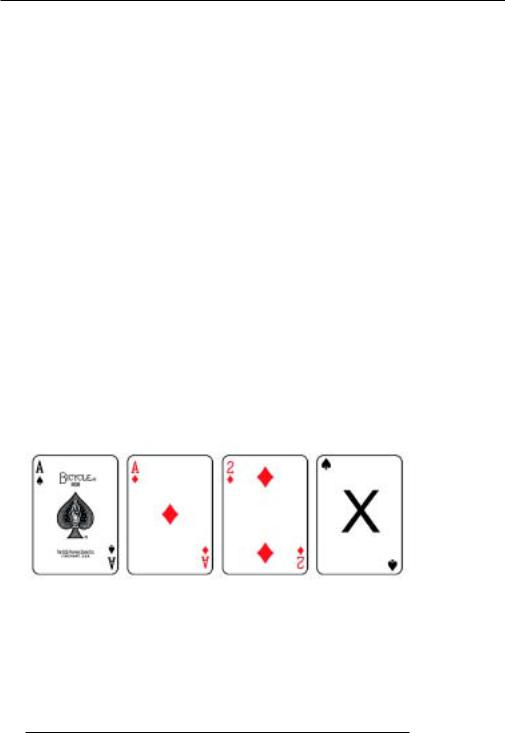
5. Odds in Omaha Hi-Lo
The probability of AA2x single suited in the hole expressed as a percentage:
|
WILLs |
|
* 100 |
= Probability as % |
|
|
Total Possibilities |
||||
|
|
|
|||
576 |
|
* 100 |
= .21% |
||
|
270,725 |
|
|||
The odds of AA2x are |
|
|
|||
Total Possibilities = 270,725
– WILLs = 576
WILLNOTs = 270,149
WILLNOTs (270,149) : WILLs (576) 270,149 : 576
Reduce 270,149 / 576 : 576 / 576
469 : 1
AA2X Double Suited
Here we will calculate the odds of having an AA2 with both Aces suited, one Ace to the Deuce and the second Ace suited the 4th card in the hole.
The total number of 4-card combinations possible from a 52-card deck is 270,725.
162

Starting Hands
There are 6 2-card combinations that can contain a pair of Aces.
To find the number of 4-card combinations that can contain AA2x double suited, multiply the number of possible pairs of Aces (6), by the number of 2-card combinations that can contain at least one Deuce that is suited to one of the Aces and to one of the 12 remaining cards of the same suit as the other Ace (2 * 12 = 24). The number of 4-card combinations that can contain one pair of Aces and one or more Deuces and is double suited to each of the Aces is
6 * 24 = 144
The probability of AA2x double suited in the hole expressed as a percentage:
WILLs |
* 100 |
= Probability as % |
||
Total Possibilities |
||||
|
|
|||
144 |
* 100 |
= .05% |
||
|
270,725 |
|||
The odds of AA2x double suited in the hole are
Total Possibilities = 270,725
– WILLs = 144
WILLNOTs = 270,581
WILLNOTs (270,581) : WILLs (144) 270,581 : 144
Reduce 270,581 / 144 : 144/ 144
1,879 : 1
163
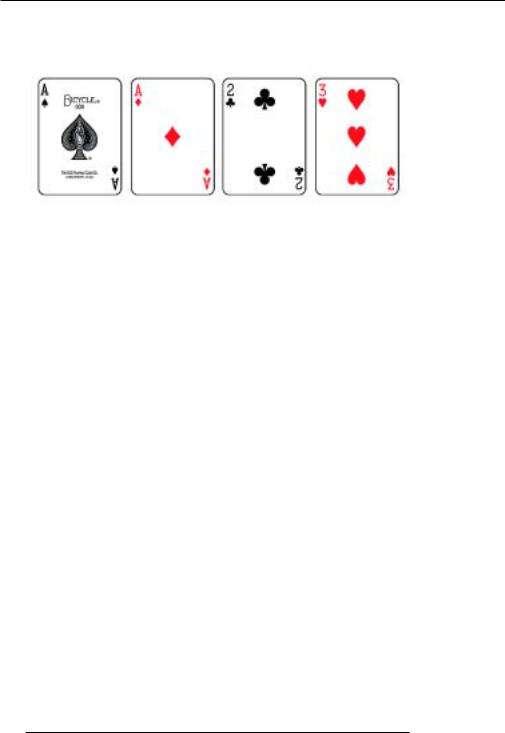
5. Odds in Omaha Hi-Lo
Any AA23/AA2K
The total number of 4-card combinations possible from a 52-card deck is 270,725.
There are 6 2-card combinations that can contain AA.
There are 4 * 4 = 16 2-card combinations that contain 23.
The number of 4-card combinations that can contain AA23 is the number of possible 2-card combinations that contain 2 Aces (6), multiplied by the number of possible 2-card combinations that contain 23 (16):
6 * 16 = 96
The probability of AA23 in the pocket expressed as a percentage is:
WILLs |
* 100 |
= Probability as % |
||
Total Possibilities |
||||
|
|
|||
96 |
* 100 |
= .035% |
||
|
270,725 |
|||
The odds of A23 in the pocket are:
Total Possibilities = 270,725
– WILLs = 96
WILLNOTs = 270,629
164
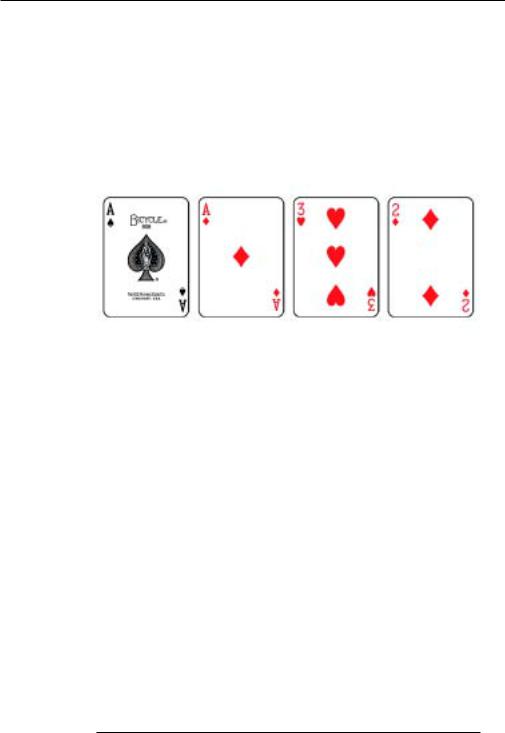
Starting Hands
WILLNOTs (270,629) : WILLs (96) 270,629 : 96
Reduce 270,629 / 96 : 96 / 96
2,819.1 : 1
AA23/AA2K Single Suited
We will calculate the odds of having an AA23 single suited to either Ace in the hole.
The total number of 4-card combinations possible from a 52-card deck is 270,725.
There are 6 2-card combinations that can contain a pair of Aces.
To find the number of 4-card combinations that can contain AA23 single suited, multiply the number of possible pairs of Aces (6), by the number of 2-card combinations that can contain at least one Deuce, one Trey and with either the 2 or the 3 suited to one of the Aces (2 * 4 = 8). The number of 4- card combinations that can contain AA23 single suited is
6 * 8 = 48
The probability of AA23 single suited in the hole expressed as a percentage is
165
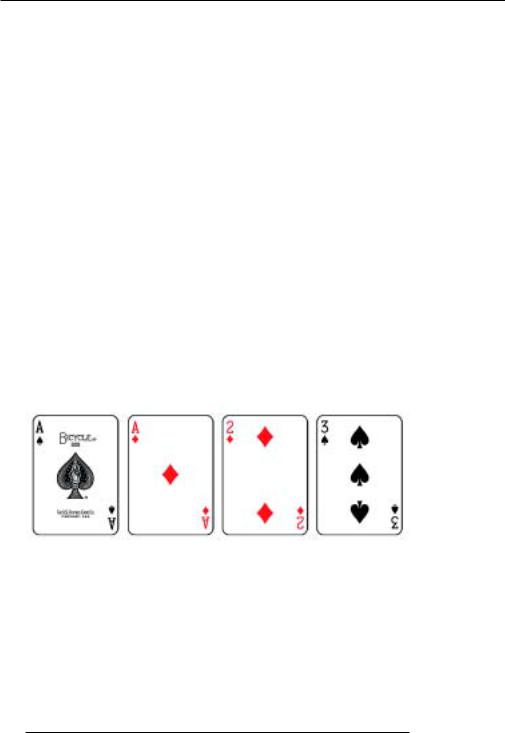
5. Odds in Omaha Hi-Lo
WILLs |
* 100 |
= Probability as % |
||
Total Possibilities |
||||
|
|
|||
48 |
* 100 |
= .018% |
||
|
270,725 |
|||
The odds of AA23 single suited in the hole are:
Total Possibilities = 270,725
– WILLs = 48
WILLNOTs = 270,677
WILLNOTs (270,677) : WILLs (48) 270,677 : 48
Reduce 270,677 / 48 : 48 / 48
5,639.1 : 1
AA23/AA2K Double Suited
Here we will calculate the odds of having an AA23 double suited to both Aces in the hole.
The total number of 4-card combinations possible from a 52-card deck is 270,725.
There are 6 2-card combinations that can contain a pair of Aces.
166
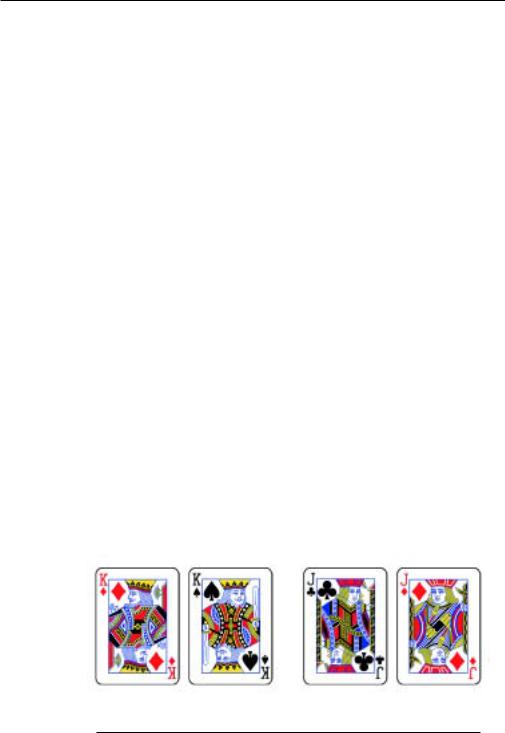
Starting Hands
There are only 2 2-card combinations of 23 that will be suited to both Aces. The number of 4-card combinations that can contain AA23 double suited is
6 * 2 = 12
The probability of AA23 double suited in the hole expressed as a percentage is
WILLs |
* 100 |
= Probability as % |
||
Total Possibilities |
||||
|
|
|||
12 |
* 100 |
= .0044% |
||
|
270,725 |
|||
The odds of AA23 double suited in the hole are
Total Possibilities = 270,725
– WILLs = 12
WILLNOTs = 270,713
WILLNOTs (270,713) : WILLs (12) 270,713 : 12
Reduce 270,713 / 12 : 12 / 12
22,559.4 : 1
2 Pair
167

5. Odds in Omaha Hi-Lo
We will calculate the odds of finding any 2 pair in the hole.
The total number of 4-card combinations possible from a 52-card deck is 270,725.
There are 78 possible 2-card combinations that can contain a pair.
To find the number of 4-card combinations that will contain 2 pair, multiply the number of possible pair combinations (78), by the number of possible pairs excluding pairs of the rank of the first pair (72):
78 * 72 = 5,616
The probability of 2 pair in the pocket expressed as a percentage is:
WILLs |
* 100 = Probability as % |
|
Total Possibilities |
||
|
270,7255,616 * 100 = 2.1%
The odds of A2 in the hole are:
Total Possibilities = 270,725
– WILLs = 5,616
WILLNOTs = 265,109
WILLNOTs (265,109) : WILLs (5,616) 265,109 : 5,616
Reduce
265,109 / 5,616 : 5,616 / 5,616
47.2 : 1
168

Starting Hands
Probably Not Playable
With the three caveats that
1.not all of the hands listed below are always playable;
2.there is some duplication among the hands in the table below; and
3.several usually playable hands are not listed;
the following gives a fair approximation of the odds of rags in the hole.
Because we are trying to find the odds of getting a nonplayable hand, the number of playable hands represents the
WILLNOTs:
Hand |
Number of Possible Hands |
|
|
AAXX |
6,768 |
|
|
A2XX |
19,600 |
|
|
A2 Suited to A |
7,104 |
|
|
A23X |
3,136 |
A23X Suited to A |
768 |
|
|
AA2X |
1,128 |
|
|
AA2X Single Suited to A |
576 |
AA2X Double Suited |
144 |
|
|
AA23 |
96 |
|
|
AA23 Single Suited |
48 |
AA23 Double Suited |
12 |
|
|
2 Pair |
5,616 |
|
|
Total Playable Hands |
44,996 |
|
|
169

5. Odds in Omaha Hi-Lo
The probability of getting a non-playable hand expressed as a percentage is:
Total Possibilities = 270,725
– WILLNOTs = 44,996
WILLs = 225,729
WILLs |
* 100 = Probability as % |
|
Total Possibilities |
||
|
225,729270,725 * 100 = 83.3%
To find the odds of getting a non-playable hand in the hole:
WILLNOTs (44,996) : WILLs (225,729) 44,996 : 225,729
Reduce
44,996 / 225,729 : 225,729 / 225,729
.2 : 1
170

Before the Flop
Before the Flop
In both Omaha High and Omaha Hi-Lo, a primary consideration is the odds of improving the hand on the Flop. In Omaha Hi-Lo, an additional concern is the likelihood that a Low hand or Low draw will be counterfeited.
Second-nut Lows, second-nut Flushes and “dummy” end Straights are all hands that can be very expensive for two reasons:
1.They are second-nut — they have a diminished chance of winning
2.They are mostly unidirectional hands — they have virtually no chance of scooping.
The tables and calculations below demonstrate the odds and probabilities that
1.Certain starting low hands will improve into Low draws on the Flop
2.Certain starting high hands will improve into High draws on the Flop
3.Either low or high starting hands will evolve into made hands on the Flop.
Certain starting low hands will be counterfeited on the Flop.
171

5. Odds in Omaha Hi-Lo
Omaha Hi-Lo — Before the Flop
Starting Hand |
Hand to Flop |
Odds |
|
|
|
AA23 |
Nut Low Draw |
.35 : 1 |
|
|
|
AA23 |
Nut Low |
4.4 : 1 |
AA23 |
Wheel or Aces Full |
65 : 1 |
|
|
|
AA23 |
Ace-High Flush Draw |
2.4 : 1 |
Double Suited |
|
|
AA23 |
Nut Low or Flush |
3.7 : 1 |
Double Suited |
or Aces Full |
|
AA23 |
Counterfeit A or 2 or 3 |
.92 : 1 |
|
|
|
AA2X |
Nut Low Draw |
.76 : 1 |
|
|
|
AA2X |
Nut Low or Aces Full |
3.3 : 1 |
AA2X |
Nut Low or Flush |
3.2 : 1 |
Suited to A |
or Aces Full |
|
A23X |
Nut Low Draw |
1.7 : 1 |
A23X |
Nut Low |
4.1 : 1 |
|
|
|
A23X |
Ace High Flush or |
3.9 : 1 |
Suited to A |
Nut Low |
|
A2XX |
Nut Low Draw |
.8 : 1 |
|
|
|
A2XX |
Nut Low |
3.5 : 1 |
|
|
|
A2XX |
Wheel |
269.3 : 1 |
|
|
|
A2XX Suited to A |
Flush or Low |
3.3 : 1 |
|
|
|
A2XX |
Counterfeit A or 2 |
1.6 : 1 |
A3XX |
Nut Low Draw |
4.4 : 1 |
|
|
|
A3XX |
Nut Low |
26 : 1 |
|
|
|
172

Before the Flop
The Calculations
These calculations will use both the comparison of sets and the combination of probabilities.
The total number of possible different 3-card Flops will be used throughout these calculations. With your 4 hole cards, the total possible 3-card Flops from the remaining 48 cards is Comb(48, 3):
(48 * 47 * 46) = 17,296 (1 * 2 * 3)
Another number that will useful in these calculations is the number of 2-card combinations possible from the remaining unseen 48 cards — Comb(48,2):
(48 |
* 47) |
= 1,128 |
|
|
(1 |
* 2) |
|
||
AA23 |
|
|
|
|
|
|
|
|
|
Starting Hand |
|
|
Hand to Flop |
Odds |
|
|
|
|
|
AA23 |
|
|
Nut Low Draw |
.35 : 1 |
AA23 |
|
|
Nut Low |
4.4 : 1 |
|
|
|
|
|
AA23 |
|
Wheel or Aces Full |
65 : 1 |
|
|
|
|
|
|
AA23 Double Suited |
|
|
Nut Flush Draw |
2.4 : 1 |
|
|
|
|
|
AA23 Double Suited |
|
Nut Low or Flush or |
3.7 : 1 |
|
|
|
|
Aces Full |
|
AA23 |
|
Counterfeit A or 2 or 3 |
.92 : 1 |
|
|
|
|
|
|
AA23 is probably the best starting hand in Omaha Hi-Lo. The odds of its improvement in either direction are better
173

5. Odds in Omaha Hi-Lo
than for almost any other hand. You will flop a nut Low draw over 74% of the time with this hand.
AA23 >>> Nut Low Draw
To flop a nut Low draw with this hand, the Flop needs to contain any 2-card combination that has 2 unpaired low cards, exactly one of which may be of the same rank as any one of the hole cards.
This calculation includes the possibility of flopping a made nut Low.
There are 32 cards in the deck below the rank of 9, and 4 of them are in the hole. The number of 2-card combinations that contain 2 cards below the rank of 9 is Comb(28, 2):
(28 * 27) = 378 (1 * 2)
This number includes 30 pairs from the ranks 4 through 8, 1 pair of Aces, 3 pairs of Deuces, and 3 pairs of Treys, for a total of 37 pairs that must be subtracted from 378:
378 – 37 = 341
From this, subtract the unpaired 2-card combinations both of which match hole cards: 6 A2 combinations, plus 6 A3 combinations, plus 9 2?3 combinations, for a total of 21 combinations that match 2 hole cards:
341 – 21 = 320
To include the possibility of flopping a made Low hand, multiply this number (320), by the number of remaining cards in the deck (48), minus the 2 Flop cards that make the
174

Before the Flop
Low hand (2), minus the 6 cards that will pair either of the first 2 Flop cards (48 – 2 – 6 = 40):
320 * 40 = 12,800
There are 12,800 3-card Flops the WILL make a nut Low draw or better:
Total Possibilities = 17,296
– WILLs = 12,800
WILLNOTs = 4,496
Odds of Flopping Nut Low Draw or Better WILLNOTs : WILLs
4,496 : 12,800 Reduce
4,496 / 12,800 : 12,800 / 12,800
.35 : 1
To express these odds as a probability:
WILLs |
* 100 = Probability as % |
|
Total Possibilities |
||
|
12,80017,296 * 100 = 74%
AA23 >>> Nut Low
To flop a nut Low with this hand, the Flop must contain 2 unpaired low cards that do not match any of the hole cards, plus a third low card that may match any of the hole cards, but may not match either of the first two cards flopped.
First you need to calculate the number of 2-card combinations that will make the nut Low draw without counterfeiting any of the hole cards.
175

5. Odds in Omaha Hi-Lo
There are 20 cards ranked 8 or lower that do not match any of the hole cards. The number of 2-card combinations —
Comb(20, 2):
(20 * 19) = 190 (1 * 2)
From the ranks 4 through 8, there are 30 possible pairs that must be subtracted from the total to indicate the number of 2-card combinations that will make the draw:
190 – 30 = 160
While the third card may counterfeit one of the hole cards and still produce a nut Low, it must not be a card above the rank of 8 and it must not pair one of the other 2 board cards. Thus there are 46 – 20 (number of cards 9 through K) — 6 (number of cards that will pair either of the board cards) = 20 possibilities for the third card. The number of 3-card Flops that WILL make a nut Low to this hand:
160 * 20 = 3,200
With a total of 17,296 possible 3-card Flops, the odds of flopping a nut Low or a Set of Aces:
Total Possibilities = 17,296
– WILLs = 3,200
WILLNOTs = 14,096
Odds of Flopping Nut Low or AAA WILLNOTs : WILLs
14,096 : 3,200 Reduce
14,096 / 3,200 : 3,200 / 3,200
4.4 : 1
176

Before the Flop
AA23 >>> Wheel or Aces Full
To flop a Wheel (A2345) with this hand, there must be both a 4 and a 5 on the board as well as a counterfeit to one of the hole cards.
There are 4 * 4 = 16 possible 45 combinations multiplied by one of the 8 cards that will counterfeit one of the hole cards:
16 * 8 = 128
128 3-card combinations will make a Wheel to this hand.
To flop Aces Full with this hand, one of the Flop cards must be an Ace and the other 2 must be paired. Remaining unseen are 1 pair of Aces, 3 pairs of Deuces, 3 pairs of Treys, and 60 pairs from the ten ranks 4 through K. With 2 unseen Aces, the number of 3-card Flops that will make Aces Full is:
67 * 2 = 134
128 + 134 = 262 3-card Flops WILL make Aces Full or a Wheel to this hand:
Total Possibilities = 17,296
– WILLs = 262
WILLNOTs = 17,034
Odds of Flopping a Wheel or Aces Full WILLNOTs : WILLs
17,034 : 262 Reduce
17,034 / 262 : 262 / 262
65 : 1
177

5. Odds in Omaha Hi-Lo
AA23 Double Suited >>> Nut Flush Draw
To flop a nut Flush draw, the Flop need only contain 2 cards of either of the 2 suits that match the hole cards. With 11 unseen cards of each of 2 suits, the number of possible 2- card combinations that will flop the nut Flush draw is
Comb(11, 2) * 2:
(11 * 10) * 2 = 110 (1 * 2)
Multiply this by 46 (48 unseen cards minus 2), to get 46 * 110 = 5,060 possible Flops that will produce a nut Flush draw or better to this hand.
This calculation includes the possibility of flopping a made nut Low.
Total Possibilities = 17,296
– WILLs = 5,060
WILLNOTs = 12,236
Odds of Flopping a Nut Flush Draw or Better WILLNOTs : WILLs
12,236 : 5,060 Reduce
12,236 / 5,060 : 5,060 / 5,060
2.4 : 1
AA23 Double Suited >>> Flush or Nut Low or Aces Full
With the caveat that there is some small overlap, we will find the number of Flops that will fill each of these hands separately, then add them to find the odds of making any of these three very strong hands.
178

Before the Flop
From the calculations above, we know that there are 3,200 Flops that will make a nut Low.
To flop an Ace-High Flush, the Flop must contain 3 cards from either of 2 suits — Comb(11, 3) * 2:
(11 * 10 * 9) * 2 = 330 (1 * 2 * 3)
Also from the work above, we know that there are 134 Flops that will make Aces Full.
There are 3,664 Flops that will make a nut Low, Ace High Flush or Aces Full to this hand:
Nut Low = 3,200
Ace High Flush = |
330 |
Aces Full = |
134 |
|
3,664 |
Odds of Flopping a Nut Low, Ace High Flush or Aces Full
WILLNOTs : WILLs 13,632 : 3,664
Reduce
13,632 / 3,664 : 3,664/ 3,664
3.7 : 1
AA23 >>> Counterfeited A or 2 or 3
To find the odds of a counterfeited A, 2 or 3 at least once on the Flop, multiply the number of 2-card combinations possible from the 48 unseen cards by the number of remaining
A’s, 2’s and 3’s — Comb(48, 2) * 8:
(48 * 47) * 8 = 9,024 (1 * 2)
179

5. Odds in Omaha Hi-Lo
Total Possibilities = 17,296
– WILLs = 9,024
WILLNOTs = 8,272
Odds of Flopping a Counterfeited A or 2 or 3 WILLNOTs : WILLs
8,272 : 9,024 Reduce
8,272 / 9,024 : 9,024/ 9,024
.92 : 1
AA2X >>> Nut Low Draw
To flop a nut Low draw with this hand, the Flop needs to contain 2 unpaired cards of the ranks 3 through 8 (no card may counterfeit either the Ace or the Deuce in the hole).
This calculation includes the possibility of flopping a made nut Low.
There are Comb(24, 2) 2-card combinations from the ranks 3 through 8 and 36 pairs:
(24 * 23) = 276 (1 * 2)
276 – 36 = 240 2-card combinations that will flop the nut Low draw. Multiply this by all of the remaining cards minus those that will counterfeit either the Ace or Deuce in the hole, 41:
240 * 41 = 9,840
With 9,840 3-card combinations that will flop the nut Low draw to this hand, the odds are
180

Before the Flop
Total Possibilities = 17,296
– WILLs = 9,840
WILLNOTs = 7,456
Odds of Flopping a Nut Low Draw WILLNOTs : WILLs
7,456 : 9,840 Reduce
7,456 / 9,840 : 9,840 / 9,840
.76 : 1
AA2X >>> Nut Low or Aces Full
To flop a nut Low with this hand, the board must contain 3 unpaired cards ranked 3 through 8. There are 6 ranks and thus Comb(24, 2) 2-card combinations minus the 36 possible pairs among these ranks:
(24 * 23) = 276 (1 * 2)
276 – 36 = 240 is the number of 2-card combinations that will flop the nut Low draw. This is multiplied by all of the remaining cards ranked 3 through 8 that are not represented by the first 2 cards of the Flop (16), to produce the number of 3-card combinations that will make a nut Low to this hand:
240 * 16 = 3,840
To flop Aces Full, the board must contain an Ace and any pair. With this hand there are 66 unseen pairs ranked 3 through K, plus 1 pair of Aces and 3 pairs of Deuces = 70 possible pairs that might appear on the board. This is multiplied by the number of unseen Aces (2), to produce the number of possible 3-card flops that will make Aces Full or better to this hand:
181

5. Odds in Omaha Hi-Lo
70 * 2 = 140
This calculation includes the possibility of flopping an AA to produce QUADS.
There are 3,840 + 140 = 3,980 possible 3-card Flops that will make a nut Low hand or Aces Full or better to this hand. The odds of this Flop are
Total Possibilities = 17,296
– WILLs = 3,980
WILLNOTs = 13,316
Odds of Flopping a Nut Low or Aces Full WILLNOTs : WILLs
13,316 : 3,980 Reduce
13,316 / 3,980 : 3,980 / 3,980
3.3 : 1
AA2X – Single Suited >>> Ace High Flush or Nut Low or Aces Full
There are 3,980 3-card Flops that will make either a nut Low hand or Aces Full. To complete this calculation we must also find the number of 3-card Flops all of the same suit as the suited Ace — Comb(11, 3):
(11 * 10 * 9) = 165 (1 * 2 * 3)
There are 3,980 + 165 = 4,145 3-card Flops that will make an Ace High Flush, a nut Low or Aces Full to this hand. The odds against one of these flops are:
Total Possibilities = 17,296
– WILLs = 4,145
WILLNOTs = 13,151
182

Before the Flop
Odds of Flopping an Ace High Flush or Nut Low or Aces Full
WILLNOTs : WILLs 13,151 : 4,145
Reduce
13,151 / 4,145 : 4,145 / 4,145
3.2 : 1
A23X >>> Nut Low Draw
To flop a nut Low draw with this hand, the Flop needs to contain 2 unpaired cards below the rank of 9 with 1 and only 1 that may pair the A, 2 or 3 in the hole.
This calculation includes the possibility of flopping a made nut Low.
There are Comb(20, 2) 2-card combinations from the ranks 4 through 8 and 30 pairs:
(20 * 19) = 190 (1 * 2)
190 – 30 = 160 is the number of 2-card combinations that will flop a nut Low draw to this hand. This is multiplied by all of the remaining cards minus the 6 that might counterfeit one of the Flop cards, 40:
160 * 40 = 6,400
With 6,400 3-card combinations that will flop the nut Low draw to this hand, the odds are:
Total Possibilities = 17,296
– WILLs = 6,400
WILLNOTs = 10,896
183

5. Odds in Omaha Hi-Lo
Odds of Flopping a Nut Low Draw WILLNOTs : WILLs
10,896 : 6,400 Reduce
10,896 / 6,400 : 6,400 / 6,400
1.7 : 1
A23X >>> Nut Low
To flop a nut Low with this hand the Flop needs to contain 3 unpaired cards below the rank of 9 with one and only one that may pair the A, 2 or 3 in the hole.
There are Comb(20, 2) 2-card combinations from the ranks 4 through 8 and 30 pairs:
(20 * 19) = 190 (1 * 2)
190 – 30 = 160 is the number of 2-card combinations that will flop a nut Low draw to this hand. This is multiplied by all of the remaining low cards minus the 6 that might counterfeit one of the flop cards (21):
160 * 21 = 3,360
With 3,360 3-card combinations that will flop the nut Low to this hand, the odds are
Total Possibilities = 17,296
– WILLs = 3,360
WILLNOTs = 13,936
Odds of Flopping a Nut Low
WILLNOTs : WILLs
13,936 : 3,360
184

Before the Flop
Reduce
13,936 / 3,360 : 3,360/ 3,360
4.1 : 1
A23X Single Suited >>> Nut Low or Ace High Flush
There are 3,360 Flops that will make a nut low.
To flop an Ace-High Flush, the Flop must contain 3 cards from the same suit as the suited Ace — Comb(11, 3):
(11 * 10 * 9) = 165 (1 * 2 * 3)
3,360 + 165 = 3,525 is the number of 3-card combinations that will flop a Nut Low or an Ace-High Flush to this hand:
Total Possibilities = 17,296
– WILLs = 3,525
WILLNOTs = 13,771
Odds of Flopping a Nut Low or Ace High Flush WILLNOTs : WILLs
13,771 : 3,525 Reduce
13,771 / 3,525 : 3,525 / 3,525
3.9 : 1
A2XX >>> Nut Low Draw
To flop a nut Low draw with this hand, the Flop must contain 2 unpaired cards of the ranks 3 through 8 with no card that counterfeits either the Ace or the Deuce in the hole.
185

5. Odds in Omaha Hi-Lo
This calculation includes the possibility of flopping a made nut Low.
There are Comb(24, 2) 2-card combinations from the ranks 3 through 8 and 36 pairs:
(24 * 23) = 276 (1 * 2)
276 – 36 = 240 is the number of 2-card combinations that will flop the nut Low draw. This is multiplied by all of the remaining cards minus those that will counterfeit either the Ace or Deuce in the hole (40):
240 * 40 = 9,600
With 9,600 3-card combinations that will flop the nut Low draw to this hand, the odds are
Total Possibilities = 17,296
– WILLs = 9,600
WILLNOTs = 7,696
Odds of Flopping Nut Low Draw WILLNOTs : WILLs
7,696 : 9,600 Reduce
7,696 / 9,600 : 9,600 / 9,600
.8 : 1
A2XX >>> Nut Low
To flop a nut Low with this hand, the board must contain 3 unpaired cards ranked 3 through 8. There are six ranks and thus Comb(24, 2) 2-card combinations minus the 36 possible pairs among these ranks:
186

Before the Flop
(24 * 23) = 276 (1 * 2)
276 – 36 = 240 is the number of 2-card combinations that will flop the nut Low draw. This is multiplied by all of the remaining cards ranked 3 through 8 that are not represented by the first 2 cards of the Flop (16), to produce the number of 3-card combinations that will make a nut Low to this hand:
240 * 16 = 3,840
Total Possibilities = 17,296
– WILLs = 3,840
WILLNOTs = 13,456
Odds of Flopping Nut Low WILLNOTs : WILLs
13,456 : 3,840 Reduce
13,456 / 3,840 : 3,840 / 3,840
3.5 : 1
A2XX >>> A Wheel (A2345)
To flop a Wheel with this hand, the board will need to show
345.
There are 4 * 4 * 4 = 64 3-card combinations that contain 345 and will make a wheel.
Total Possibilities = 17,296
– WILLs = 64
WILLNOTs = 17,232
Odds of Flopping a Wheel
WILLNOTs : WILLs
17,232 : 64
187

5. Odds in Omaha Hi-Lo
Reduce 17,232 / 64 : 64 / 64
269.3 : 1
A2XX Suited Ace >>> Nut Low or Ace Flush
There are 3,840 Flops that will make a nut Low to this hand.
To flop an Ace-High Flush the Flop must contain 3 cards from the same suit as the Ace — Comb(11, 3):
(11 * 10 * 9) = 165 (1 * 2 * 3)
3,840 + 165 = 4,005 is the number of 3-card combinations that will flop a nut Low or an Ace-High Flush to this hand:
Total Possibilities = 17,296
– WILLs = 4,005
WILLNOTs = 13,291
Odds of Flopping a Nut Low or an Ace High Flush WILLNOTs : WILLs
13,291 : 4,005 Reduce
13,291 / 4,005 : 4,005 / 4,005
3.3 : 1
A2XX >>> Counterfeit Either or Both the Ace or the Deuce at Least Once
To find the odds of a counterfeited A or 2 at least once on the Flop, multiply the number of 2-card combinations possible from the 48 unseen cards by the number of remaining Aces and Deuces — Comb(48, 2) * 6:
188

Before the Flop
(48 * 47) * 6 = 6,768 (1 * 2)
Total Possibilities = 17,296
– WILLs = 6,768
WILLNOTs = 10,528
Odds of Counterfeiting A or 2 WILLNOTs : WILLs
10,528 : 6,768 Reduce
10,528 / 6,768 : 6,768 / 6,768
1.6 : 1
A3XX >>> Nut Low Draw
To flop a nut Low draw with this hand, the Flop needs to contain at least one Deuce and one other low card other than an Ace or Trey.
This calculation includes the possibility of flopping a made nut Low.
There are 20 cards ranked 4 through 8 plus 4 Deuces. Thus there are 20 * 4 = 80 2-card combinations that contain a Deuce and one other low card. After these 2 cards are dealt, there are 40 remaining cards that will not counterfeit the Ace or the Trey. 80 * 40 = 3,200 3-card combinations will flop a nut Low draw to this hand:
Total Possibilities = 17,296
– WILLs = 3,200
WILLNOTs = 14,096
Odds of Flopping Nut Low Draw
WILLNOTs : WILLs
14,096 : 3,200
189

5. Odds in Omaha Hi-Lo
Reduce
14,096 / 3,200 : 3,200 / 3,200
4.4 : 1
A3XX >>> Nut Low
To flop the Nut Low with this hand, the board must contain 2 unpaired cards ranked 4 through 8 plus one Deuce.
There are 20 cards that rank 4 through 8. The number of 2- card combinations that contain 2 unpaired cards ranked 4 through 8 is Comb(20, 2) minus the 30 pairs of these ranks:
(20 * 19) = 190 (1 * 2)
190 – 30 = 160 is the number of 2-card combinations that will flop the Nut Low draw. The 160 is multiplied by 4 (the number of Deuces) to produce 640 3-card combinations that will flop the nut draw to this hand:
Total Possibilities = 17,296
– WILLs = 640
WILLNOTs = 16,656
Odds of Flopping Nut Low WILLNOTs : WILLs
16,656 : 640 Reduce
16,656 / 640 : 640 / 640
26 : 1
190

After the Flop
After the Flop
Nut Hand or Nut Draw
Because almost the entire deck (77%) is distributed before the Flop and is held in players’ hands, it is almost certain that the Flop will have hit one or more of those hands and the presence of the nut hand and/or the nut draw is a high probability.
Only the very best starting hands offer a significant advantage over the others, because of the large number of cards held in the players’ hands and the small number of cards in the Flop.
Once the Flop has hit the board, you have 7 of the 9 cards that will make your best and final hand for both Low and High. Money expectation aside, as a general rule only continue to invest in the hand with the nuts or a reasonable draw to the nuts in either direction, preferably both. If you don’t have them, the nuts that is, there are many chances that at least one of your opponents does.
The Omaha player who receives optimal return from his game is the player who is able to continuously convince his opponents to put more money into the pot with weaker hands and lesser draws.
Money & Expectation After the Flop
After the betting on the Flop in limit games, the stakes usually double and the cost to continue in the hand increases. As
191

5. Odds in Omaha Hi-Lo
each card is placed on the board the likelihood of improvement decreases. As each bet or raise is made or called the money odds get better.
In Omaha Hi-Lo the pot is often split, and many times will be split among more than 2 players.
Omaha Hi-Lo is one of the few games in poker where the absolute nut hand can wind up losing money. It is also a game where, given usually large pots, playing uni-directional hands, regardless of strength, can carry a much-reduced expectation over the same hand in non-split games.
In split games, the difference between scoop and not-scoop is dramatic. If 4 players each have $200 invested in an $800 Omaha Hi-Lo pot:
Scooper Earns $600 Profit
Low Half Earns $200 Profit
Quartered Low Earns $000 Profit
With a nut Low draw or made nut Low hand, primary considerations are:
1.Whether there will be 3 low cards on the board on the Flop or by the River
2.Whether the hand is the draw or the nuts
3.The likelihood the low will be quartered or worse
4.The chance the low will be counterfeited
5.The presence of a backup or extra low card in the hole in case of a counterfeit on the Turn or River.
With a made nut High hand or nut High draw, consider:
192

After the Flop
1.Whether or not there will be a possible Low to split the pot
2.The likelihood the hand or draw is the nuts
3.Whether the hand will make or remain the nuts
4.For certain hands, whether the board will pair
5.The likelihood that the high hand is the only high among several low hands/draws.
To optimize the opportunity with a double-nut/scoop hand or draw, consider:
1.If the hand is already made in one or both directions
2.The likelihood the hand will be made in either or both directions
3.If the hand/draw is the nuts in either or both directions
4.The odds the hand will be broken/counterfeited by the end
5.With a true double-nut hand, how to get more money into the pot.
Odds of Improvement
Once the Flop has hit the board, you have 7 of the 9 cards that will make your best and final hand. After the Flop and with 2 cards to come, regardless of the hand, any player still involved must know
♦The odds of improvement on the next card (the Turn)
193

5.Odds in Omaha Hi-Lo
♦The odds of improvement over the next two cards (the Turn and the River)
♦The odds of hitting certain Runner-Runner hands.
Odds the Turn Card Will . . .
Having just one backup low card in the hole increases the probability of turning a nut Low hand from a nut Low draw from 35.6% to 55.6%.
With both a Low draw and a Flush draw, the player has almost a 50-50 (47%) chance of making either the Low or the Flush and still has another card to come. A player does not need big money odds to make this hand very playable after the Flop.
With the multiple-way draw possible in Omaha Hi-Lo, the odds of improvement on the Turn can exceed 50%. With a Low draw, Straight draw and a Flush draw, the player will turn a made hand 60% of the time.
With certain 5-card holdings after the Flop, the odds that these holdings will improve with the laying of the Turn card are
After the Flop |
Hand to Turn |
Odds |
|
|
|
Low Draw |
Low |
1.8 : 1 |
|
|
|
Low Draw with |
Low |
1.1 : 1 |
Backup Low Card |
|
|
Wheel Draw |
Wheel |
10.3 : 1 |
|
|
|
Low Draw or Made Low |
Counterfeit Low |
6.5 : 1 |
|
|
|
Low Draw & Flush Draw |
Low or Flush |
1.1 : 1 |
|
|
|
194

|
|
|
After the Flop |
|
|
|
|
|
|
|
After the Flop |
Hand to Turn |
Odds |
|
|
|
|
|
|
|
Flush Draw |
Flush |
4 : 1 |
|
|
|
|
|
|
|
Open Straight Draw |
Straight |
4.6 : 1 |
|
|
|
|
|
|
|
Gut-Shot Straight Draw |
Straight |
10.25 : 1 |
|
|
|
|
|
|
|
Open Straight & |
Straight, Flush |
.67 : 1 |
|
|
4 Flush & Low Draw |
or Low |
|
|
|
2 Pair |
Full House |
10.3 : 1 |
|
|
|
|
|
|
|
Set |
Full House |
5.4 : 1 |
|
|
|
or Quads |
|
|
|
Made Straight or Flush |
Pair the Board |
4 : 1 |
|
|
|
|
|
|
The Calculations
With the Turn card to come, the odds calculation for the various hands is straightforward. The only number that changes is the number of outs.
After the Flop and before the Turn, counting your 4 hole cards, there are 45 unseen cards:
Total Possibilities = 45
Total Possibilities – WILLs (Outs) = WILLNOTs
Odds = WILLNOTs : WILLs (Outs)
Low Draw >>> Low
With 2 low cards of 2 different ranks in the hole and the same on the board, cards from 4 ranks, 4 * 4 = 16 will complete the low draw:
Total Possibilities = 45
– WILLs = 16
195

5. Odds in Omaha Hi-Lo
WILLNOTs = 29
Odds of Turning a Low WILLNOTs : WILLs
29 : 16 Reduce
29 / 16 : 16 / 16
1.8 : 1
WILLs |
* 100 = Probability as % |
|
Total Possibilities |
||
|
4516 * 100 = 35.6%
Low Draw with Backup Low Card in the Hole >>>
Low
With 3 low cards of 3 different ranks in the hole and 2 on the board, cards from the 3 remaining ranks, 3 * 4 = 12, plus any of the 9 cards that will counterfeit any one of the hole cards, 12 + 9 = 21, cards will complete the nut low draw:
Total Possibilities = 45
– WILLs = 21
WILLNOTs = 24
Odds of Turning a Low WILLNOTs : WILLs
24 : 21 Reduce
24 / 21 : 21 / 21
1.1 : 1
WILLs |
* 100 = Probability as % |
|
Total Possibilities |
||
|
196

After the Flop
4521 * 100 = 46.7%
Wheel (A2345) Draw >>> Wheel
With a Wheel draw, there are only 4 cards that will make the Wheel:
Total Possibilities = 45
– WILLs = 4
WILLNOTs = 41
Odds of Turning a Wheel WILLNOTs : WILLs
41 : 4 Reduce
41 / 4 : 4 / 4
10.3 : 1
Low Draw or Made Low Hand >>> Counterfeit Either of 2 Low Cards in the Hole
There are 6 cards that will counterfeit either of 2 low cards in the hole:
Total Possibilities = 45
– WILLs = 6
WILLNOTs = 39
Odds of Turning a Counterfeit to Low Card in the Hole WILLNOTs : WILLs
39 : 6 Reduce
39 / 6 : 6 / 6
6.5 : 1
197

5. Odds in Omaha Hi-Lo
Low Draw & Flush Draw >>> Low or Flush
There are 16 cards that will complete the Low plus 9 cards that will make the flush, minus 4 cards that are already counted among those that will make the low, 16 + 9 – 4 = 21:
Total Possibilities = 45
– WILLs = 21
WILLNOTs = 24
Odds of Turning a Low or a Flush WILLNOTs : WILLs
24 : 21 Reduce
24 / 21 : 21 / 21
1.1 : 1
Flush Draw >>> Flush
There are 9 cards that will make the Flush on the Turn:
Total Possibilities = 45
– WILLs = 9
WILLNOTs = 36
Odds of Turning a Flush WILLNOTs : WILLs
36 : 9 Reduce
36 / 9 : 9 / 9
4 : 1
Open Ended Straight Draw >>> Straight
There are 8 cards that will complete the Straight:
198

After the Flop
Total Possibilities = 45
– WILLs = 8
WILLNOTs = 37
Odds of Turning a Straight WILLNOTs : WILLs
37 : 8 Reduce
37 / 8 : 8 / 8
4.6 : 1
Gut-Shot Straight Draw >>> Straight
There are 4 cards that will complete the Straight:
Total Possibilities = 45
– WILLs = 4
WILLNOTs = 41
Odds of Turning a Straight WILLNOTs : WILLs
41 : 4 Reduce
41 / 4 : 4 / 4
10.3 : 1
Low Draw, Flush Draw & Open Ended Straight Draw >>> Low, Flush or Straight
There are 27 cards that will make a Straight, a Flush or a Low to this great draw:
Total Possibilities = 45
– WILLs = 27
WILLNOTs = 18
199

5. Odds in Omaha Hi-Lo
Odds of Turning a Flush or a Straight or a Low WILLNOTs : WILLs
18 : 27 Reduce
18 / 27 : 27 / 27
.67 : 1
WILLs |
* 100 = Probability as % |
|
Total Possibilities |
||
|
4527 * 100 = 60%
2 Pair >>> Full House
There are 4 cards that will make a Full House with 2 Pair:
Total Possibilities = 45
– WILLs = 4
WILLNOTs = 41
Odds of Turning a Full Boat WILLNOTs : WILLs
41 : 4 Reduce
41 / 4 : 4 / 4
10.3 : 1
3 of a Kind >>> Full House or Quads
There are 7 cards that will turn a Boat or Quads with a Set involving a pair in the hole:
Total Possibilities = 45
– WILLs = 7
WILLNOTs = 38
200

After the Flop
Odds of Turning a Boat or Quads WILLNOTs : WILLs
38 : 7 Reduce
38 / 7 : 7 / 7
5.4 : 1
Turn Card Will Pair the Board
There are 9 cards that will pair one of the 3 board cards:
Total Possibilities = 45
– WILLs = 9
WILLNOTs = 36
Odds of Pairing the Board WILLNOTs : WILLs
36 : 9 Reduce
36 / 9 : 9 / 9
4 : 1
Odds with 2 Cards to Come
With 2 cards to come there are 4 possibilities:
1.You will hit none of your outs on either card
2.You will hit one of your outs on the Turn
3.You will hit one of your outs on the River
4.You will hit one of your outs on the Turn and another on the River.
The most liberal of these calculations figures the odds of hit-
201

5. Odds in Omaha Hi-Lo
ting an out on either the Turn or the River, or hitting an out on both the Turn and the River.
Some notable points about making certain hands with 2 cards to come are
♦Most Low draws have an excellent chance of completion with two cards to come.
♦With a Low draw, the Low will complete 49% of the time.
♦With a Low draw and a backup low card in the hole the Low will complete 69.4% of the time.
♦With 2 cards to come you will only counterfeit one of the 2 low cards in the hole once in every four draws.
♦With a Flush draw and a Low draw the player will make either or both the Low or the Flush over 72% of the time with 2 cards to come.
♦With unpaired hole cards and an unpaired board after the Flop, the board will show a pair by the River 42% of the time.
The odds of hitting at least one of the available outs on either or both the Turn and the River are
After the Flop |
Hand After River Card |
Odds |
|
|
|
Low Draw |
Low |
1.03 : 1 |
Low Draw with |
Low |
.4 : 1 |
Backup Low Card |
|
|
Wheel Draw |
Wheel |
4.8 : 1 |
|
|
|
Low Draw or Made Low |
Counterfeit Low |
3 : 1 |
|
|
|
202

|
|
|
After the Flop |
||
|
|
|
|
|
|
|
After the Flop |
Hand After River Card |
|
Odds |
|
|
|
|
|
|
|
|
Flush Draw |
Flush |
|
1.75 : 1 |
|
|
|
|
|
|
|
|
Low Draw & |
Low or Flush |
|
.4 : 1 |
|
|
Flush Draw |
|
|
|
|
|
Low Draw & |
Low & Flush |
|
8.2 : 1 |
|
|
Flush Draw |
|
|
|
|
|
Open Straight Draw |
Straight |
|
2.1 : 1 |
|
|
|
|
|
|
|
|
Gut-Shot |
Straight |
|
4.8 : 1 |
|
|
Straight Draw |
|
|
|
|
|
2 Pair |
Full House or Quads |
|
4.6 : 1 |
|
|
|
|
|
|
|
|
Set |
Full House or Quads |
|
1.9 : 1 |
|
|
Made Straight |
Pair the Board |
|
1.4 : 1 |
|
|
or Flush |
|
|
|
|
|
|
|
|
|
|
The Calculations
After the Flop and before the Turn card has been dealt, there are 45 unseen cards. When calculating the odds with 2 cards to come, an important number is the total possible 2-card combinations that can be made from the remaining unseen 45 cards — Comb(45, 2):
(45 * 44) = 990 (1 * 2)
To find the WILLs, add the number of possible 2-card combinations that will contain 1 and only 1 of the available outs to the number of 2-card combinations that will contain 2 out cards.
Low Draw >>> Low with 2 Cards to Come
With a Low draw, 16 of the unseen 45 cards will make a Low. There are 6 cards among the 45 that will counterfeit one of
203

5. Odds in Omaha Hi-Lo
the low cards in the hole. Of the 45 unseen cards there are 16 that will make the Low and 23 that can combine with one of those 16 to make the Low without counterfeiting one of the low cards in the hole.
16 * 23 = 368 is the number of 2-card combinations, one card of which will make the Low.
Comb(16, 2) is the number of 2-card combinations that contain 2 cards that will make the Low, including pairs:
(16 * 15) = 120 (1 * 2)
120 2-card combinations will contain 2 low cards and still complete the Low without counterfeiting either of the low cards in the hole.
368 + 120 = 488 possible 2-card combinations WILL make the Low:
Total Possibilities = 990
– WILLs = 488
WILLNOTs = 502
Odds of a Low with 2 Cards to Come WILLNOTs : WILLs
502 : 488 Reduce
502 / 488 : 488 / 488
1.03 : 1
WILLs |
* 100 = Probability as % |
|
Total Possibilities |
||
|
488990 * 100 = 49%
204

After the Flop
Low Draw with Backup Low Card in the Hole >>>
Low with 2 Cards to Come
With a Low draw and a backup low card in the hole, 12 of the unseen 45 cards will make a Low. A Low can also be made by counterfeiting any 1 of the 3 low cards in the hole. 12 + 9 = 21 cards among the 45 that will make the Low.
21 * 24 = 504 is the number of 2-card combinations, one card of which will make the low.
Comb(21, 2) is the number of 2-card combinations that contain 2 cards either of which will make a Low, including pairs. To make this Low, none of those 2-card combinations may counterfeit more than one rank of the cards in the hole.
27 2-card combinations each of which contain a card that counterfeits a different rank in the hole, must be subtracted from Comb(21, 2) to find the number of 2-card combinations that will contain 2 low cards and still successfully make a Low to this hand:
(21 * 20) = 210 (1 * 2)
210 – 27 = 183
504 + 183 = 687 possible 2-card combinations WILL make the low:
Total Possibilities = 990
– WILLs = 687
WILLNOTs = 303
205

5. Odds in Omaha Hi-Lo
Odds of a Low with 2 Cards to Come WILLNOTs : WILLs
303 : 687 Reduce
303 / 687 : 687 / 687
.4 : 1
WILLs |
* 100 = Probability as % |
|
Total Possibilities |
||
|
990687 * 100 = 69%
Wheel Draw >>> Wheel with 2 Cards to Come
With a Wheel draw, only 4 of the unseen 45 cards will make the Wheel. As long as this last card to the Wheel is one of the 2 final board cards, it will not affect the value of the hand if 1 of the 2 last cards counterfeits either a board card or a hole card. Of the 45 unseen cards, 4 will make the Wheel and the remaining 41 can combine with one of these 4 to make the Wheel.
4 * 41 = 164 is the number of 2-card combinations, one card of which will make the Wheel.
Comb(4, 2) is the number of 2-card combinations that contain 2 cards that will make the Low, including pairs:
(4 * 3) = 6 (1 * 2)
6 2-card combinations will contain 2 Wheel cards and still complete the Low regardless of counterfeiting either of the low cards in the hole.
206

After the Flop
164 + 6 = 170 possible 2-card combinations WILL make the Wheel:
Total Possibilities = 990
– WILLs = 170
WILLNOTs = 820
Odds of a Wheel with 2 Cards to Come WILLNOTs : WILLs
820 : 170 Reduce
820 / 170 : 170 / 170
4.8 : 1
Low Draw >>> Counterfeit One or More Low Cards in the Hole with 2 Cards to Come
With a Low draw there are 6 cards that can counterfeit either or both low cards in the hole. 6 of the unseen 45 cards will counterfeit the Low and 39 will not.
6 * 39 = 234 is the number of 2-card combinations, one card of which will counterfeit one of the low cards in the hole.
Comb(6, 2) is the number of 2-card combinations in which both cards match one or both of the low cards in the hole:
(6 * 5) = 15 (1 * 2)
234 + 15 = 249 possible 2-card combinations WILL counterfeit at least one of the 2 low cards in the hole:
Total Possibilities = 990
– WILLs = 249
WILLNOTs = 741
207

5. Odds in Omaha Hi-Lo
Odds of Counterfeiting
At Least 1 of 2 Low Cards in the Hole WILLNOTs : WILLs
741 : 249 Reduce
741 / 249 : 249 / 249
3 : 1
Flush Draw >>> Flush with 2 Cards to Come
With a Flush draw and 45 unseen cards, 9 cards will make the Flush and 36 will not.
9 * 36 = 324 is the number of 2-card combinations, one card of which will make the Flush.
Comb(9, 2) is the number of 2-card combinations that contain 2 cards either of which make the Flush:
(9 * 8) = 36 (1 * 2)
324 + 36 = 360 possible 2-card combinations WILL make the Flush:
Total Possibilities = 990
– WILLs = 360
WILLNOTs = 630
Odds of Making a Flush with 2 Cards to Come WILLNOTs : WILLs
630 : 360 Reduce
630 / 360 : 360 / 360
1.75 : 1
208

After the Flop
Flush Draw & Low Draw >>> Flush or Low
With a Flush draw and a Low draw there are 16 low cards that will complete the Low. 4 of these are of the same suit as the draw, so there are 16 + 5 = 21 cards that will make either the Flush or the Low. 21 of the unseen 45 cards will make the Flush or the low and 24 will not.
21 * 24 = 504 is the number of 2-card combinations, one card of which will make either the Flush or the low.
Comb(21, 2) is the number of 2-card combinations that contain 2 cards both of which can make either the Flush or the low:
(21 * 20) = 210 (1 * 2)
504 + 210 = 714 possible 2-card combinations WILL make the Flush:
Total Possibilities = 990
– WILLs = 714
WILLNOTs = 276
Odds of a Flush or a Low with 2 Cards to Come WILLNOTs : WILLs
276 : 714 Reduce
276 / 714 : 714 / 714
.4 : 1
WILLs |
|
* 100 |
= Probability as % |
||
Total Possibilities |
|||||
|
|
||||
714 |
|
* 100 |
= 72% |
||
|
990 |
|
|||
209

5. Odds in Omaha Hi-Lo
Low Draw & Flush Draw >>> Flush & Low
With a Flush draw and a Low draw, there are 12 cards that will make the Low without making the Flush, and 9 cards that will make the Flush without making the Low.
12 * 9 = 108 is the number of 2-card combinations that will make both the Flush and the Low:
Total Possibilities = 990
– WILLs = 108
WILLNOTs = 882
Odds of Making BOTH a Flush and a Low with 2 Cards to Come WILLNOTs : WILLs
882 : 108 Reduce
882 / 108 : 108 / 108
8.2 : 1
Open Ended Straight Draw >>> Straight
With a Straight draw and 45 unseen cards, there are 8 cards that will make the Straight and 37 will not.
Therefore, 8 * 37 = 296 is the number of 2-card combinations, one card of which will make the Straight.
Comb(8, 2) is the number of 2-card combinations that contain 2 cards either of which will make the Straight:
(8 * 7) = 28 (1 * 2)
210

After the Flop
296 + 28 = 324 possible 2-card combinations WILL make the Straight:
Total Possibilities = 990
– WILLs = 324
WILLNOTs = 666
Odds of Making a Flush with 2 Cards to Come WILLNOTs : WILLs
666 : 324 Reduce
666 / 324 : 324 / 324
2.1 : 1
Gut-Shot Straight Draw >>> Straight with 2 Cards to Come
With a gut-shot Straight draw and 45 unseen cards, there are 4 cards that will make the Straight and 41 will not.
4 * 41 = 164 is the number of 2-card combinations, one card of which will make the Straight.
Comb(4, 2) is the number of 2-card combinations that contain 2 cards either of which will make the Straight:
(4 * 3) = 6 (1 * 2)
164 + 6 = 170 possible 2-card combinations that WILL make the Straight:
Total Possibilities = 990
– WILLs = 170
WILLNOTs = 820
211

5. Odds in Omaha Hi-Lo
Odds of Making a Gut-Shot Straight with 2 Cards to Come
WILLNOTs : WILLs 820 : 170 Reduce
820 / 170 : 170 / 170
4.8 : 1
2 Pair >>> Full House or Quads
With 2 pair, assuming no pairs in the hole, there are 4 cards, any one of which will make a Full House or Quads. 4 of the unseen 45 cards will make the hand and 41 will not.
4 * 41 = 164 is the number of 2-card combinations, one card of which will make the Boat.
Comb(4, 2) is the number of 2-card combinations that contain 2 cards either of which make the Boat or Quads:
(4 * 3) = 6 (1 * 2)
In addition there are 8 pairs that can also make the Boat.
164 + 6 + 8 = 178 possible 2-card combinations that WILL make the Boat or Quads:
Total Possibilities = 990
– WILLs = 178
WILLNOTs = 812
Odds of making a Full Boat or Quads with 2 Cards to Come WILLNOTs : WILLs
812 : 178
212

After the Flop
Reduce
812 / 178 : 178 / 178
4.6 : 1
Set >>> Full House or Quads
With a Set involving a pair in the hole and 45 unseen cards, there are 7 cards that will make a Boat or Quads and 38 will not.
7 * 38 = 266 is the number of 2-card combinations, one card of which will make the Boat or Quads.
Comb(7, 2) is the number of 2-card combinations that contain 2 cards, either of which will make the Boat or Quads:
(7 * 6) = 21 (1 * 2)
In addition, there are 54 different pairs that can come in the last 2 cards to make the Full House.
266 + 21 + 54 = 341 possible 2-card combinations that WILL make the Boat or Quads:
Total Possibilities = 990
– WILLs = 341
WILLNOTs = 649
Odds of making a Full Boat or Quads with 2 Cards to Come WILLNOTs : WILLs
649 : 341 Reduce
649 / 341 : 341 / 341
1.9 : 1
213

5. Odds in Omaha Hi-Lo
Unpaired Hole Cards >>> Board Will Show a Pair
There are 9 cards than can pair one of the three board cards and 36 will not.
9 * 36 = 324 is the number of 2-card combinations, one card of which will pair the board.
Comb(9, 2) is the number of 2-card combinations that contain 2 cards either of which will pair the board:
(9 * 8) = 36 (1 * 2)
In addition there are 57 pairs that can also come to create a pair on the board.
324 + 36 + 57 = 417 possible 2-card combinations that WILL pair the board:
Total Possibilities = 990
– WILLs = 417
WILLNOTs = 573
Odds the Board Will Pair with 2 Cards to Come WILLNOTs : WILLs
573 : 417 Reduce
573 / 417 : 417 / 417
1.4 : 1
WILLs |
* 100 = Probability as % |
|
Total Possibilities |
||
|
990417 * 100 = 42%
214

After the Flop
Runner — Runner
Remember — runner-runners don’t complete very often and in most cases require extraordinary money odds to be played profitably. No one card will do it.
The Calculations
The 2 most common ways to calculate the odds of hitting a runner-runner after the Flop are
1.Calculate the number of 2-card combinations that WILL do the job and compare that to the total possible 2-card combinations to find the number of 2- card combinations that WILLNOT complete the hand.
2.Multiply the probability of the first runner by the probability of the second runner and then convert that probability to odds.
This section demonstrates both approaches.
For the combination, we need to know the total possible 2- card combinations from the remaining 45 unseen cards:
(45 * 44) = 990 (1 * 2)
Below are the odds and calculations:
After The Flop |
Runner – Runner |
Odds |
|
|
|
Back Door Low Draw |
Low |
5.2 : 1 |
|
|
|
Back Door Wheel Draw |
Wheel |
21.5 : 1 |
|
|
|
215

5. Odds in Omaha Hi-Lo
After the Flop |
Runner – Runner |
Odds |
|
|
|
Back Door Flush Draw |
Flush |
26.5 : 1 |
|
|
|
Back Door Open Ended |
Straight |
19.6 : 1 |
Straight Draw |
|
|
4 Unpaired Hole Cards |
Set |
81.5 : 1 |
|
|
|
4 Unpaired Hole Cards |
Pair 2 Hole Cards |
66.56 : 1 |
|
or Set |
|
2 Pair in the Hole |
Quads |
494 : 1 |
|
|
|
Open Back Door |
Straight Flush |
329 : 1 |
Straight Flush Draw |
|
|
|
|
|
Back Door Low Draw >>> Runner-Runner Low
With 2 low cards in the hole and 1 usable low card on the board, even if the board low card is paired, there are 20 cards of 5 ranks, any unpaired 2 of which will make the runnerrunner Low. Comb(20, 2) minus the 30 pairs possible among the cards from these 5 ranks is the number of 2-card combinations that will make the runner-runner Low:
(20 * 19) = 190 (1 * 2)
190 – 30 = 160 possible 2-card combinations that WILL make a runner-runner Low:
Total Possibilities = 990
– WILLs = 160
WILLNOTs = 830
Odds of a Runner-Runner Low
WILLNOTs : WILLs
830 : 160
Reduce
216

After the Flop
830 / 160 : 160 / 160
5.2 : 1
Back Door Wheel Draw >>> Runner-Runner Wheel
With 2 wheel cards in the hole and 1 usable wheel card on the board, even if the board wheel card is paired, there are 8 cards of 2 ranks, any unpaired 2 of which will make the runnerrunner Wheel. Comb(8, 2) minus the 12 pairs possible among the cards from these 2 ranks, is the number of 2-card combinations that will make the runner-runner Wheel
(8 * 7) = 28 (1 * 2)
28 – 12 = 16 possible 2-card combinations that WILL make a runner-runner Wheel:
Total Possibilities = 990
– WILLs = 16
WILLNOTs = 974
Odds of a Runner-Runner Wheel WILLNOTs : WILLs
974 : 16 Reduce
974 / 16 : 16 / 16
60.9 : 1
Back Door Flush Draw >>> Runner-Runner Flush
With 2 suited cards in the hole and 2 suited cards on the board, there are 9 cards any 2 of which will make the runnerrunner Flush. Comb(9, 2) is the number of 2-card combinations that will make the runner-runner Flush:
217

5. Odds in Omaha Hi-Lo
(9 * 8) = 36 (1 * 2)
36 possible 2-card combinations that WILL make a runnerrunner Flush:
Total Possibilities = 990
– WILLs = 36
WILLNOTs = 954
Odds of a Runner-Runner Flush WILLNOTs : WILLs
954 : 36 Reduce
954 / 36 : 36 / 36
26.5 : 1
Open Backdoor 3-Straight >>> Runner-Runner Straight
With 3 connected cards above 2 and below K in rank, and with two of those cards in the hole, there are 3 sets of 2-card combinations that will make the Straight:
218
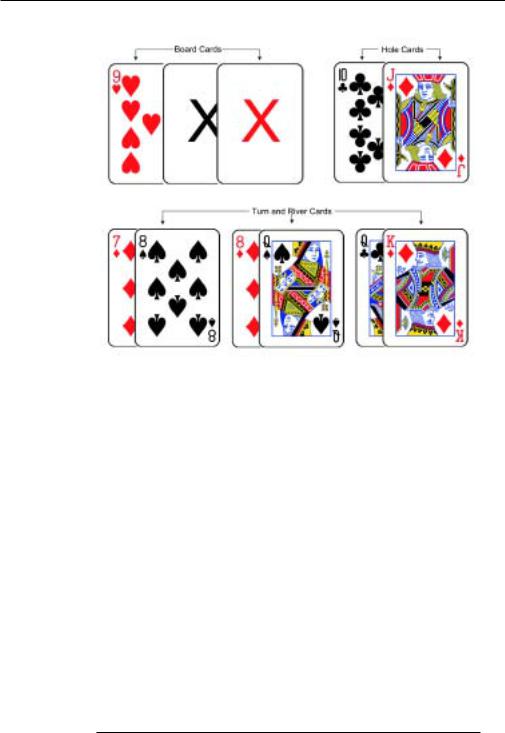
After the Flop
For each of these 3 sets there are 4 * 4 = 16 possible combinations. There is a total of 3 * 16 = 48 2-card combinations that will make the Straight shown:
Total Possibilities = 990
– WILLs = 48
WILLNOTs = 942
Odds of a Runner-Runner Straight WILLNOTs : WILLs
942 : 48 Reduce
942 / 48 : 48 / 48
19.6 : 1
219

5. Odds in Omaha Hi-Lo
4 Unpaired Cards in the Hole >>> Runner-Runner Set
With 4 unpaired cards in the hole, to make a runner-runner Set the pair that matches one of the 4 hole cards will have to hit on the Turn and another on the River. There are 3 pairs outstanding for each of the 4 ranks in the hole. 4 * 3 = 12 pairs will make a Set to one of the hole cards:
Total Possibilities = 990
– WILLs = 12
WILLNOTs = 978
Odds of a Runner-Runner Set WILLNOTs : WILLs
978 : 12 Reduce
978 / 12 : 12 / 12
81.5 : 1
4 Unpaired Hole Cards >>> Runner-Runner 2 Pair or Set
With 4 unpaired cards in the hole there are 12 cards, any 2 of which will make a runner-runner 2 pair or a Set to the cards in the hole — Comb(12, 2):
(12 * 11) = 66 (1 * 2)
66 possible 2-card combinations that WILL make a runnerrunner 2 pair or a Set to 4 unpaired cards in the hole:
Total Possibilities = 990
– WILLs = 66
WILLNOTs = 924
220

After the Flop
Odds of a Runner-Runner 2 Pair or Set WILLNOTs : WILLs
924 : 66 Reduce
924 / 66 : 66 / 66
14 : 1
2 Pair in the Hole >>> Runner-Runner Quads
With 2 pair in the hole, there are only 2 pairs or 2 2-card combinations that WILL make runner-runner Quads to this hand:
Total Possibilities = 990
– WILLs = 2
WILLNOTs = 988
Odds of a Runner-Runner Quads WILLNOTs : WILLs
988 : 2 Reduce
988 / 2 : 2 / 2
494 : 1
Open Back Door 3-Straight Flush >>> RunnerRunner Straight Flush
With 2 suited and connected cards above 2 and below K in rank on the board, and 1 in the hole, there are 3 2-card combinations that WILL make a Straight Flush
221
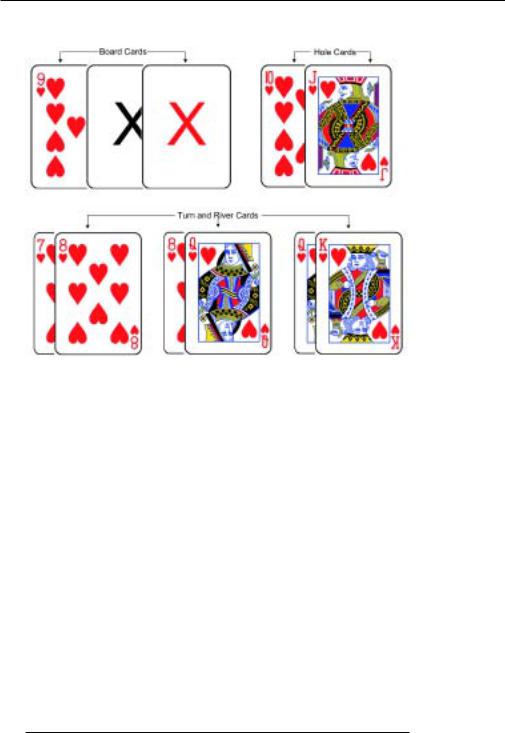
5. Odds in Omaha Hi-Lo
Total Possibilities = 990
– WILLs = 3
WILLNOTs = 987
Odds of a Runner-Runner Straight Flush WILLNOTs : WILLs
987 : 3 Reduce
987 / 3 : 3 / 3
329 : 1
222

Before the Last Card
Before the Last Card
After the Turn card has hit the board, you have only 1 more card to come and only 1 more chance to improve your hand.
With 1 card to come there are still 2 rounds of betting left and in most limit games those rounds are at a higher stake than the first two.
With the higher cost to continue and the hand mostly made, players should have a precise strategy in order to remain involved.
At this juncture players have 8 out of the 9 cards that will be used to make both Low and High hands. The player should have a very good idea of his chances:
1.That he is drawing dead in either or both directions
2.That he has the nuts or will make the nuts for either or both the High or the Low
3.That he will be quartered or counterfeited for the Low.
Odds of Improvement With Only 1 Card to Come
With only 1 card to come, some noteworthy points from the table below include:
1.With a Low draw, you will make the Low roughly 36% of the time
223

5.Odds in Omaha Hi-Lo
2.Having just 1 backup low card in the hole raises your probability of making the Low with only 1 card to come from 36% to 48%
3.While some of the odds seem quite favorable, a player strong in only 1 direction should remember that most of the time he will be playing for only half the pot.
Here is a table that shows the odds of improving certain common drawing hands on the last card:
Hand – Draw |
Make on Last Card |
Odds |
|
|
|
Low Draw |
Low |
1.75 : 1 |
|
|
|
Low Draw with Backup |
Low |
1.1 : 1 |
Low Card in the Hole |
|
|
Low Draw & Flush Draw |
Low or Flush |
1.1 : 1 |
|
|
|
2 Pair |
Full House |
10 : 1 |
Open Ended |
Straight |
4.5 : 1 |
Straight Draw |
|
|
Gut-Shot Straight Draw |
Straight |
10 : 1 |
Flush Draw |
Flush |
3.9 : 1 |
|
|
|
Flush Draw & Open |
Straight or Flush |
1.9 : 1 |
Straight Draw |
|
|
1 Pair & Flush Draw |
Set or Flush |
3 : 1 |
|
|
|
Open Straight |
Straight Flush |
21 : 1 |
Flush Draw |
|
|
4 Unpaired Hole Cards |
Pair Any Hole Card |
2.7 : 1 |
|
|
|
224

Before the Last Card
The Calculations
With one card to come, the odds calculation for the various hands is straightforward. The only number that changes is the number of outs.
After the Turn card has hit the board, there are 4 cards in the hole, 4 on the board and 44 unseen cards.
Total Possibilities = 44
Total Possibilities – WILLs (Outs) = WILLNOTs
Odds = WILLNOTs : WILLs (Outs)
Low Draw >>> Low
With a Low draw there are 16 cards from 4 ranks that can come on the River to make the Low:
Total Possibilities = 44
– WILLs = 16
WILLNOTs = 28
Odds of Making a Low WILLNOTs : WILLs
28 : 16 Reduce
28 / 16 : 16 / 16
1.75 : 1
WILLs |
* 100 = Probability as % |
|
Total Possibilities |
||
|
1644 * 100 = 36%
225

5. Odds in Omaha Hi-Lo
Low Draw with Backup Low Card in the Hole >>>
Low
With a Low draw and a backup low card in the hole, there are 21 cards that can come on the River to make the Low:
Total Possibilities = 44
– WILLs = 21
WILLNOTs = 23
Odds of Making a Low
with Backup Low Card in the Hole WILLNOTs : WILLs
23 : 21 Reduce
23 / 21 : 21 / 21
1.1 : 1
WILLs |
* 100 = Probability as % |
|
Total Possibilities |
||
|
4421 * 100 = 48%
Low Draw & Flush Draw >>> Low or Flush
With a Low draw and a Flush draw, there are 21 cards that can come on the River to make the Flush or the Low:
Total Possibilities = 44
– WILLs = 21
WILLNOTs = 23
Odds of Making a Flush or a Low WILLNOTs : WILLs
23 : 21
226

Before the Last Card
Reduce
23 / 21 : 21 / 21
1.1 : 1
2 Pair >>> Full House
With 2 pair there are only 4 cards that can come on the River to make the Full House:
Total Possibilities = 44
– WILLs = 4
WILLNOTs = 40
Odds of Making a Boat with 2 Pair WILLNOTs : WILLs
40 : 4 Reduce
40 / 4 : 4 / 4
10 : 1
Open Ended Straight Draw >>> Straight
With an open ended Straight draw there are 8 cards that can come on the River to make the Straight:
Total Possibilities = 44
– WILLs = 8
WILLNOTs = 36
Odds of Making a Straight WILLNOTs : WILLs
36 : 8 Reduce
36 / 8 : 8 / 8
4.5 : 1
227

5. Odds in Omaha Hi-Lo
Gut-Shot Straight Draw >>> Straight
With a gut-shot Straight draw there are only 4 cards that can come on the River to make the Straight:
Total Possibilities = 44
– WILLs = 4
WILLNOTs = 40
Odds of Making a Straight WILLNOTs : WILLs
40 : 4 Reduce
40 / 4 : 4 / 4
10 : 1
Flush Draw >>> Flush
With a Flush draw there are 9 cards that can come on the River to make the Flush:
Total Possibilities = 44
– WILLs = 9
WILLNOTs = 35
Odds of Making a Flush WILLNOTs : WILLs
35 : 9 Reduce
35 / 9 : 9 / 9
3.9 : 1
228

Before the Last Card
Open Ended Straight Draw & Flush Draw >>>
Flush or Straight
With an open-ended Straight draw and a Flush draw there are 15 cards that can come on the River to make either the Flush or the Straight:
Total Possibilities = 44
– WILLs = 15
WILLNOTs = 29
Odds of Making a Straight or a Flush WILLNOTs : WILLs
29 : 15 Reduce
29 / 15 : 15 / 15
1.9 : 1
1 Pair & Flush Draw >>> Flush or Set
With a Pair and a Flush draw there are 11 cards that can come on the River to make the Flush or a Set on the River:
Total Possibilities = 44
– WILLs = 11
WILLNOTs = 33
Odds of Making a Flush or a Set WILLNOTs : WILLs
33 : 11 Reduce
33 / 11 : 11 / 11
3 : 1
229

5. Odds in Omaha Hi-Lo
Open Ended Straight Flush Draw >>> Straight Flush
With an open ended Straight Flush draw there are only 2 cards that can come on the River to make the Flush:
Total Possibilities = 44
– WILLs = 2
WILLNOTs = 42
Odds of Making a Straight Flush WILLNOTs : WILLs
42 : 2 Reduce
42 / 2 : 2 / 2
21 : 1
4 Unpaired Hole Cards >>> Pair a Hole Card
With 4 unpaired hole cards there are 12 cards that will pair one of them on the River:
Total Possibilities = 44
– WILLs = 12
WILLNOTs = 32
Odds of Making a Pair on the River WILLNOTs : WILLs
32 : 12 Reduce
32 / 12 : 12 / 12
2.7 : 1
230

Before ThetLastRiverCardBet
The River Bet
All the cards are out. There is no chance of improving your hand. You can win a piece of the pot in one of two ways:
1.By having the best hand in a showdown
2.By using strategy to cause your opponent(s) to fold their cards.
Your Total Odds of winning the pot are the odds that your hand will win in a showdown PLUS the odds that you can manipulate your opponent(s) into giving up their stake in the pot.
In Omaha Hi-Lo, however, because of the high probability of a call from either or both a strong Low or a strong High hand, moves are not as useful as they can be in Hold’em.
It is at this point in a hand of Omaha Hi-Lo where the concepts of Value-Bet and even more so — Value-Call — are most plainly demonstrated.
By this stage, three of the four rounds of betting have been completed and the pot can be monstrous. Pots are often large enough to offer positive money odds to a variety of seemingly risky propositions.
Value-Bluffs might not be effective at this point. But marginal strength in both directions could easily warrant a
Value-Call.
___________________
231

